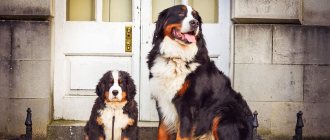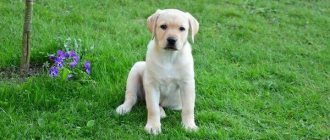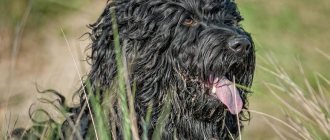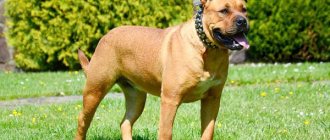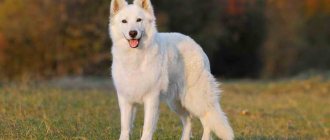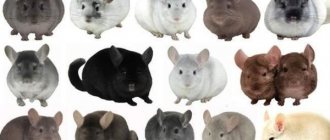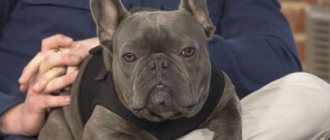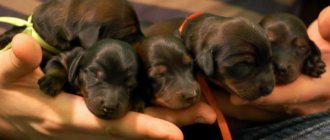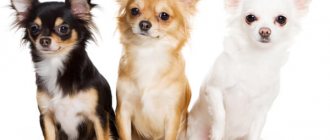The Black Labrador is an amazing dog that stands out from all retrievers with its bright colors. The dog not only has an interesting appearance, but also an easy-going character. White dogs - Labradors - have long been no rarity, but a black representative is not so often seen on the street. There is always increased attention to him, and the owners who have a “bright dog” in their lives say that they will never get another breed. What is unusual about this “cute tailed one?”
According to the standards, there are several varieties with different colors, all of which are representatives of Labrador Retrievers.
Breed standard and conformation
According to the established official standard FCI No. 122, there are several varieties of color and certain external parameters.
Chocolate Labrador is quite common as well as white. Outwardly, this is a large-built dog, with good bones, and has fairly developed muscles throughout the body. Movable, active and cheerful. The look is direct, confident.
Movements are free and easy. By nature, this breed is a hunter, which will happily accompany you on fishing, mini trips, and walks in the forest. They are wonderful companions, friends for all occasions, and simply excellent family pets. They are great with children, do not require special care, just regular hygiene measures and constant monitoring by a veterinarian. Life expectancy is 12 – 14 years.
According to the established standard, the color can be:
- Rich chocolate (the color of the nose and lips is the same, coloring is required);
- Black (rich, uniform);
- Fawn color: Silver Labrador, golden and cream, light gray (liver).
In matings there can always be representatives of different color types, regardless of the color of the parents. It is possible that competent breeders always know who to expect in the litter; you can calculate the color by about 80% based on ancestors.
But sometimes it happens that sunrises are not so easy to predict, and the kids turn out to be surprisingly “different sizes”. The most interesting thing is that the history of the formation of the retriever as a breed began with a black dog, and only then other colors were officially recognized.
Dimensions, weight and other distinctive features
White Labrador Retrievers have a number of features:
| Factor | Males | Bitches |
| Height (cm) | 56-57 | 54-56 |
| Weight, kg) | 27-40 | 27-35 |
| Body | Wide chest, rounded ribs, short wide loin. | |
| Head | Medium size. The transition from the forehead to the muzzle is clearly defined. | |
| Wool | Smooth, short, thick and even. | |
| Paws | Rounded, have well-developed pads | |
| Ears | Triangular, close to the head, light. | |
| Eyes | From hazel to brown. | |
Chocolate handsome retriever
The Chocolate Labrador is an exceptional dog, pleasant in appearance, with a charming character. Labrador retrievers of bright chocolate color are quite rare, they look impressive. The pleasant glossy shimmer of the fur is their calling card, and their owners proudly call them “chocolate.”
They differ in shades and saturation:
- From light to rich Gorky;
- Liver, close to gray.
According to the standard, the coat of such a representative should be of only one tone, there should not be any spots of foreign color, a small spot in the chest area is allowed, but this is not desirable either.
Paint over the mucous membranes, eyelids and nose, dark color - should be full, eye color - brown, copper shade, pure brown or a little honey. Externally they are very beautiful and impressive dogs.
Fawn type
The fawn Labrador, once upon a time, was unfairly regarded as a breed defect. Recognition of the color officially became possible only in 1924, the most interesting thing is that in the modern world - they lead in quantity, although previously they were not in price.
Some prefer exclusively light Labradors and consider only this type to be purebred in appearance.
Shades for it can be varied:
- Cream;
- Peach;
- Light red;
- Golden - sandy;
- Gray (not saturated);
Pure whites practically do not exist; if the dog is light in color, it must have some kind of shade; spots of foreign color, especially dark ones, are not allowed. The color of the eyelids, lips, nose is only dark, the eyes are brown.
Black Dog
The color of Labradors is black, the most beautiful and noticeable in our opinion. They are the breed ancestors of all retrievers; their exterior characteristics are the closest to ideal.
A black Labrador puppy looks like a little imp that has been smeared in ash, the color is exclusively black, full of “black night” richness. It was precisely these dogs that attracted the attention of Europeans, who began breeding. This color is predominant in all retrievers; each individual carries it in its own genotype.
- The most beautiful are the black representatives, their coat is of a glossy type, with a beautiful iridescence; light spots are not allowed throughout the body, only a slight spot on the chest is allowed, but nothing more.
A prerequisite is to completely paint over the eyelids, eyes, nose and lips. The eyes are brown, a dark shade is considered ideal, that is, the darker the eyes, the better.
Description of the breed
External characteristics of a white Labrador:
- height varies from 54 to 57 cm depending on gender;
- body weight – from 27 to 40 kg;
- the chest is rounded, the loin is short;
- head of medium size, proportional to build;
- the coat is thick, short, smooth;
- limbs are round;
- the ears are triangular, slightly adjacent to the head;
- eye color from hazel to dark brown;
- The color is light, close to cream; an adult dog may have a golden tint.
Atypical colors
The silver Labrador is a dog of an unusual color, which is currently not officially recognized. Some representatives may be spotted, or Dudley (albino). Representatives of this color often have unpainted mucous membranes, nose and eyelids. They can also differ in eye color, usually they have blue eyes, but they can also be completely different.
- Golden representatives of “Dudley” can unfortunately have health problems, and their color is not provided for by the standard.
The spotted dog looks impressive, just like Dudley and the silver one, it is not acceptable; rather, they are regarded as a breeding marriage; they have frequent health problems, including: diseases of the visual organs, hearing organs, deviations from behavioral norms .
They will not be allowed to breed and most likely will not have full documents, but this does not prevent them from living a long dog’s life, albeit with peculiar problems. An important point is that such representatives must be sterilized and neutered, otherwise breaks in the endocrine system are possible.
Conscientious breeders should not leave puppies of this type, due to possible health and mental problems; they are usually removed from the litter at the time the dog gives birth.
Advantages and disadvantages
The Labrador Retriever has the following advantages::
- attractive appearance;
- friendliness, kindness to other animals and people;
- good receptivity of teams;
- ease of care and education;
- owner-oriented.
Among the disadvantages of the breed are the following::
- excessive kindness, which is why the animal cannot be a good guard;
- love of water, which is why the pet often runs through muddy puddles;
- likes to dig through garbage, often brings trophies to the owner in the form of dead rats and birds;
- can chew on absolutely any objects, which is why furniture often suffers;
- snore.
Effect of coat color
The colors of standard Labradors are a certain condition, but in general they do not affect any special exterior trait. They are almost identical in character, but many say that black is more courageous, calm and loving.
- Cream - more cheerful and good-natured, they are often called a dog - without age, at any age the dog is cheerful and active, able to play.
By nature this dog is a hunter, active and devoted, faithful. They are aimed at performing certain physical activities. They are very receptive to training, they will always stand up for the owner, no matter what color the pet is - they are an ideal friend and comrade.
Life expectancy, and what diseases are they susceptible to?
Over the course of life, problems with excess weight may arise, which lead to the development of a number of chronic diseases and shorten the pet’s life expectancy.
Among the common diseases in Labradors, the following are noted::
- dysplasia of the hip or elbow joint;
- osteochondrosis – the joint in the area of the knees, shoulders and elbows is not formed correctly;
- cataracts, retinal detachment and other eye diseases;
- hypothyroidism – deficiency of thyroid hormones;
- allergic reactions manifested by damage to the skin (eczema, dermatitis);
- ichthyosis (in this breed it occurs without damage to the immune system) - profuse dandruff;
- nasal parakeratosis – crusts and cracks on the nose.
Character of black beauties
The color of a black Labrador does not affect its character, but many owners distinguish them as calmer and emotionally stable
- Labrador, both fawn and black, loves to get lost in leaves, mud and just run around in puddles. They sincerely love their owner and are ready to protect him around the clock, protecting peace and life. Such a dog is always ready to play and go explore new places.
They are active and require constant exercise and attention. It is difficult for them to bear parting with their owner, they can become sad, and sometimes even refuse to eat. They treat children and other representatives of the animal world calmly, and will live peacefully with cats without infringing on their rights.
These are ideal friends, ready to both spend time on the couch and run with a person in the morning. They happily accept affection, trying to give the owner double positive emotions. They are grateful, loyal and honest.
They will not show aggression without a reason, but they are always ready to fully stand up for themselves and their family. Fans of swimming in open waters. The Labrador's character is a real gift for a family man; the dog will live well in a family with children and other animals.
Raising an animal must be done from an early puppy age; they require regular training. It’s good if you decide to undergo professional training with a specialist, where you can better build a relationship with the animal.
Personality Traits of a White Labrador
White Labrador Retrievers are very intelligent and quick-witted animals.
In this regard, they can even be compared with such well-known breeds as:
Labradors want to be useful, so they always listen to their owners. This is confirmed by numerous official ratings, where representatives of this breed occupy an honorable place in the top five in terms of intelligence and aptitude for training.
White Labrador Retrievers are very cheerful and playful, making them excellent companions for children . They are friendly towards strangers and other animals.
Despite the friendliness of white Labrador retrievers, they should not be housed in the same room as parrots or other birds, as this will trigger the dog’s hunting instinct.
Labrador retrievers are dogs created for living in a family; they literally become an integral part of it..
These animals cannot imagine their life without communication, but at the same time they subtly sense the mood of their owners, never getting bored. They are able to adapt not only to the mood of the owner, but even to his habits.
Due to the high intellectual abilities of the white Labrador retriever, it is quite possible to teach him the following actions:
- bring slippers;
- turn on the light;
- open or close doors.
Maintenance and care
Black beauties are a little easier to care for, as they do not require frequent bathing or dusting, but certain hygiene procedures must be carried out regularly and thoroughly.
- Bathing: bathe as the animal gets dirty, use only dog shampoos and conditioners, the water should not be hot or very cold. The animal will have its own soft, terry towel for a long time. In warm weather, you can allow your pet to swim in open water, after which you will need to rinse it with regular running water. Gray dogs - Labradors and peach representatives, are the dirtiest; they constantly require their fur to leak after a walk, otherwise fingertips will accumulate on them in large quantities. It is enough to wipe them with a damp cloth after a walk.
- Sun on a walk: chocolate Labradors and black Labradors have a hard time withstanding open sun and can get overheated. With them it is necessary to limit exposure to the open sun, avoiding direct sunlight is best. It is better if you take a walk in the forest - a park, or somewhere in the shade. It is not recommended to give an increased load, just take a walk, and leave all educational processes and active games for the evening - when the sun has already set.
If you notice that the dog is breathing more actively, then go home, give him something to drink and put him in a cool place. It’s good if you take water while walking; if the animal is walking heavily or is clearly in a semi-fainting state, wet the fur and let it drink, take a break and also go home.
Labrador and its colors affect physical activity in a certain way, only during the hot period, the rest of the time there is no difference.
- Claws: a mandatory procedure, you will need to get used to it from an early puppy age. Cut your nails with a cutter 1 – 2 times a month.
- Wool: comb 2-3 times a week, every day during the shedding period, using a special slicker brush. Treatment of fur against fleas and ticks is regular and seasonal.
- Vaccination: all vaccinations must be done on time and according to schedule, visit the veterinarian once every half a year for a preventive examination.
- Ears and eyes: you will need to treat your ears from excess wax 2-3 times a month; a simple cotton swab or ear swab will do for this; refrain from sudden movements so as not to damage the ear. The eyes will need to be treated 2 times a week with a cotton swab moistened with a special care lotion; a decoction of herbs with an antiseptic effect is also suitable.
- Teeth: you will have to brush your teeth yourself with a brush, you will need to be given special treats - those that clean off plaque, sold in specialized stores.
All care procedures must be performed regularly, it is especially important to monitor the state of health, any manifestations that are not typical for an animal (bad breath, apathy, refusal to eat) all this is my evidence of health problems, do not delay visiting the veterinarian.
Nutrition
There are two types of power:
- Feeding with dry food;
- Feeding with natural products;
Which type to choose is up to you, our recommendation is dry food. When purchasing a puppy, breeders must inform you what food they start feeding the puppies with. It is recommended not to change it until the baby grows up. The change occurs smoothly, gradually, adding new food in small quantities, then gradually increasing its amount.
Ready-made feed
Labrador chocolate and all the others tolerate dry food feeding well, the advantage of such feeding is obvious:
- They do not require cooking;
- Fully balanced;
- Contains a complex of minerals and vitamins;
- Designed ideally for breed, age and physical activity;
- They do not require special knowledge to create a diet.
It is necessary to give preference to premium food, they are ideal for your pet, do not cause food allergies and are able to keep the dog in the right shape. Ideal food would be “Go”, “Barking Heads” “Almo Nature”, “Ontario” “Farmina”.
Adults eat 2 times a day, small puppies 4-5 times. Be sure to provide access to drinking water.
Natural nutrition
The complexity of formulating a diet when feeding natural foods is compounded by the fact that you will need to separately select a complex of vitamins and mineral supplements. Calculation: 30 grams of protein per 1 kg of weight, the rest for vegetables/fruits/porridge - 20% of the total.
Products allowed for dogs:
- Non-fat meat without bones, skin and fat (chicken, turkey, beef);
- Dairy products (cheese, cottage cheese, kefir);
- Sea fish, cleaned, without bones;
- Vegetables: grated cheese or finely chopped (zucchini, carrots, cucumber, pumpkin);
- Fruits;
- Bone flour;
- Vegetable fats;
- Porridge: buckwheat, rice, wheat;
- By-products: liver, heart, lung, tripe;
- Complex of vitamins and minerals;
- Raw eggs (rare);
- Greenery.
It is prohibited to give:
- Tubular bones;
- Sweet;
- Pasta;
- Potato;
- Flour;
- Grape;
- Any spices, salty, peppery, hot.
- It is forbidden to feed from the table.
Unfortunately, representatives of this breed are prone to obesity; it is not recommended to overfeed your pet. And be sure to provide sufficient physical activity.
Training
It is necessary to start the educational process from an early age, starting training from 2 to 3 months. You will need to learn simple commands first:
- "To me";
- "Ugh";
- "It is forbidden";
- "Sit";
- "Lie";
- "Near";
Time for training is no more than 40 minutes a day until the age of 4 months, after which increase the load and time. Alternate with active games. You will need to be patient and persistent.
- You must not: yell at the puppy, use physical force, or be aggressive or rude. After 4 months, you can start training with a specialist, and then continue on your own.
How to choose a puppy and price
First you need to choose a breeder and inquire about the availability of puppies. Study your parents' pedigree, look at their health studies. Babies go to new homes at the age of 1.5 - 2 months, at this moment they have vaccinations, puppy metrics, after which they change to pedigree.
The puppy must be:
- Standard color;
- With full coloring of mucous membranes, nose and lips;
- Active and friendly;
- No aggression or display of fear;
- The baby should be proportionally built and move freely;
- A prerequisite is the correct bite.
- The price for puppies starts from 43 thousand rubles, show class puppies cost twice as much.
Reviews
- Irina, 32 years old, Moscow
Fawn Labradors are the coolest, trust me. My dog is perfect, faithful, devoted. We went to training for three months and were absolutely delighted. A beggar, of course, but where would we go without it? We wanted to get another one, but we can’t decide what color to get. My son wants black, and I want chocolate. We are still choosing, I recommend it to everyone - you won’t regret it.
- Vladimir, 40 years old, Krasnodar
My dog is Red, the color “dove” as my wife says, this is her favorite chocolate. We go fishing together and love to stay in a tent overnight. He has established himself as a true companion, hunter and just a friend. I try to spend more time in nature, but lately we have often started to bring in ticks, so I had to reduce my activity a little.
Share link:
